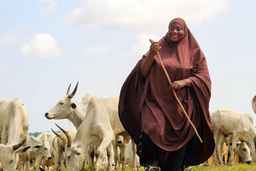Supporting Kids in Loss - a Q&A with Professor Sarah Egan
Published in Behavioural Sciences & Psychology

Explore the Research
Project SKIL: Supporting Kids in Loss
Grief is very common in children. Around two thirds of children have experienced the death of a family member or…
Professor Sarah Egan is a Clinical Psychologist based at the School of Population Health within Curtin University in Perth, Australia. Her research focuses around anxiety, depression and eating disorders in children and adolescents, and the advancement of Cognitive Behavioural Therapy, again particularly in relation to young people.
I came across her research recently when she registered a new study, Project SKIL, on the ISRCTN Registry. The study fits really neatly into the Sustainable Development Goals target 3.4, which focuses on promoting mental health & wellbeing. She kindly agreed to share her experience of working with young people navigating grief as part of this Q&A.
AJ: Tell us a bit about your research, and what’s led you to this study?
SE: What led to this study originally was a co-produced systematic review and meta-analysis on grief in youth that we did in 2022, funded by Wellcome as a part of their reviews focused on understanding active ingredients of anxiety and depression in youth. What was clear as a result of that review was that cognitive behaviour therapy for grief in children and adolescents is effective, however there were no published studies at that time available of the treatment as an internet delivered treatment, all studies were of face-to-face treatment.
Clearly this is a major gap in the literature given the vast majority of youth will never have access to specialist CBT for grief as a face-to-face treatment. This led to the first study we conducted in 2024 on an adolescent internet CBT for grief treatment programme. That study was successful, so we have secured further funding from Channel 7 Telethon Trust, Western Australia to continue our work in 2025 to adapt the treatment to a younger age range of 6-12 years.

AJ: How does the support children need when they experience some kind of loss differ from the support teenagers or adults might need?
SE: I think the main difference is that a parent or caregiver will need to be involved in delivering the self-help treatment. In adolescents, we developed a self-guided treatment. At least for children aged 10 years and under, a parent/caregiver would need to be involved as a supported treatment to be able to make sense of the treatment and practice the skills. Our treatment is flexible for 11 and 12 year olds, where they may either prefer to complete it as a self-help treatment alone, or with support from their parent or caregiver.
AJ: Can you explain what support children receive as part of Project SKIL?
SE: It is a completely self-guided treatment. We deliver the treatment via the internet to the parent/caregiver with detailed instructions on the website about how they can best support their child in engaging in the treatment. It consists of the suggestion to do 8 modules over a 4-week period. There are lots of images, colourful graphics, and videos of children talking about how they have used CBT to help with distress surrounding grief.
 We co-designed the internet intervention with a group of 11 children who had experienced bereavement of either a parent or sibling. One of the many great suggestions that they had was to ensure each page was read aloud, so younger children can click on each webpage and hear it being read, like an audio book.
We co-designed the internet intervention with a group of 11 children who had experienced bereavement of either a parent or sibling. One of the many great suggestions that they had was to ensure each page was read aloud, so younger children can click on each webpage and hear it being read, like an audio book.
AJ: Have you had feedback from carers on Project SKIL and its predecessor, Project SAIL?
SE: No, we restricted the feedback to that of the adolescent in the previous version. We are also interested in children's feedback in this current project, so will be asking directly for their feedback, rather than that of their caregiver.
AJ: Project SKIL is doesn’t just focus on grief in the concept of death, but also other forms of loss like parental divorce. Is it unusual for a study to take non-death related grief into account?
SE: Yes I think it is unusual. Our reason for including non-death related grief, like parental divorce, was in the meta-analysis I mentioned, when we engaged with young people to understand their views, they had a strong preference that interventions should be broad and not only look at bereavement, but also cover things like parental separation, which many talked about as a major problem they had faced that was distressing but for which there was no help available they could find.
AJ: Do you think it’s important that children receive this kind of support immediately when they experience grief, or would it benefit them further down the line too?
SE: I don't think it needs to be immediate. There is a lot to be said for just seeing how the course of grief which is a normal process runs for the child, and then if there is a problem down the track, suggesting they could access some help. I think the programme can be used for an immediate grief experience particularly to further understanding about grief being normal, but many of the techniques stem from interventions for prolonged grief, i.e., when significant distress or impairment is experienced 1 year or more after, say, a bereavement. I think the intervention is appropriate across the span of recent or a long time ago since the loss, but maybe not necessary as an immediate treatment.
AJ: Between SKIL and SAIL, your programmes have supported children aged 6-12 and adolescents. Do you think this kind of intervention is possible for under 6 year olds with a carer’s support? Or are other approaches more effective?
SE: I think under 6 years of age maybe needs a different approach. The strategies in the program are mostly a bit complex for very young children. A more simple approach would be needed and one focused perhaps more on parenting strategies.
AJ: What would you say to a carer who was considering encouraging their child to take part in Project SKIL?
SE: To try it out and support their child if they are interested in the intervention.
AJ: What are your hopes for Project SKIL as this study progresses?
SE: Of course, as with every study, our hope is that recruitment is successful, and that we get a sufficient number of participants to make the study viable. I think it will be a little tricky given we need parent or caregiver involvement, and everyone is so busy. But we are optimistic that the intervention is needed and that we will be successful. If we can prove that it is feasible and effective, we would then like to run a larger trial.

I've learnt so much from discussing this research and reading about Project SKIL, and particularly really value how Professor Egan and her team have put the children and adolescents they're working with right at the centre of this study, in terms of how they'll take on feedback and hopefully be able to scale this up.
Thanks again to Professor Sarah Egan for taking the time to discuss this really important research - we're looking forward to reading the results once the study is complete!
This Q&A forms part of Issue 3 of the Sustainable Development Goal 3 Newsletter, which will focus on Children & Young People. Follow my colleague Alice Coe on Research Communities to be among the first to read the full issue, and to receive notifications about future SDG 3 Newsletters.
You can read more blogs from ISRCTN, the UK's Clinical Study Registry, here. It's our 25th anniversary this year, so we'll be posting regular content celebrating the milestone.
Follow the Topic
-
ISRCTN: The UK’s Clinical Study Registry

A primary clinical trial registry recognised by WHO and ICMJE that accepts studies involving human subjects or populations with outcome measures assessing effects on human health and well-being, including studies in healthcare, social care, education, workplace safety and economic development.
Your space to connect: The Psychedelics Hub
A new Communities’ space to connect, collaborate, and explore research on Psychotherapy, Clinical Psychology, and Neuroscience!
Continue reading announcement




Please sign in or register for FREE
If you are a registered user on Research Communities by Springer Nature, please sign in